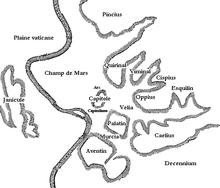Campus Martius
The Campus Martius ( German Marsfeld ) was a more than 250 hectare area of ancient Rome in public ownership. It was dedicated to Mars , the Roman god of war , and was used as sheep and horse pasture as long as the military did not need it for training purposes. Because it was outside the Pomerium , the Campus Martius was the natural place for receptions for foreign rulers and ambassadors who were not allowed to cross this line. Foreign cults could build their temples here.
The Campus Martius itself was a lowland plain west of the Via Lata , the modern Corso, and the bend of the Tiber . Under the name of ager Tarquinorum , according to legend, it used to be a wheat field that belonged to the last king Lucius Tarquinius Superbus and was burned down during the overthrow that established the Roman Republic . With an old altar dedicated to the god of war, Campus Martius was closely linked to the soldiers and the army, who originally often used it for exercises. Later it was often the site of the Roman triumphal procession , the celebration after the end of a successful campaign. Victorious generals had buildings erected here to commemorate their victories. Gnaeus Octavius , for example, after his victory over the Macedonian king Perseus in 167 BC. Build the Porticus Octavia .
From Sulla's time , plots of land on the Martius campus were sold or given to influential Romans who misused the common land to build insulae (large rental houses) and villas. Later it became a place for civil and militia gatherings . Pompey had 55 BC BC build the first stone theater on the Martius campus, the Theater of Pompey . Marcus Vipsanius Agrippa redesigned the swampy ground with ponds and baths in an environment of parks and temples, and built the Porticus Argonautarum and the Laconicum Sudatorium. In 33 BC Octavian (later Augustus ) consecrated the new building of the Porticus Octavia here, which was built from the spoils of the Dalmatian War.
In the northern part of Campus Martius, the Augusti solarium and, in connection with it, the Ara Pacis ( altar of peace) were built by the Senate at the same time to commemorate Augustus' peace-building. The two buildings were built on January 30th, 9 BC. Inaugurated. They were intended to symbolize the successful completion of Augustus' efforts to stabilize the empire.
As the city grew at the end of the Republic and in the early Principate , more and more buildings were erected on Campus Martius. Significant among them are the Augustus mausoleum and the Marcellus theater . The campus was eventually filled with a multitude of temples and public buildings, circuses, theaters, porticos, baths, monuments and obelisks. At the end of the 2nd century, for example, the Marcus Aurelius column was erected in honor of the emperor Marcus Aurelius .
After the invasions of the Great Migration cut the aqueducts and thus destroyed the city's water supply, the rapidly dwindling population left the surrounding hills and gathered on Campus Martius - now dependent on the water of the Tiber and victims of its floods. The Campus Martius thus comprised the main part of Rome until the city began to grow again as the capital of reunified Italy from 1870 onwards. The name is still preserved today as the district of Campo Marzio .
literature
- Giovanni Battista Piranesi : Campus martius antiquae urbis. Rome 1762 (reprinted Bergamo 1975 and Würzburg 1977).
- Filippo Coarelli : Rome. An archaeological guide. Philipp von Zabern, Mainz 2000, ISBN 3-8053-2685-8 , pp. 258-301.
- Jon Albers: Campus Martius. The urban development of the Field of Mars from the Republic to the Middle Imperial Period. Reichert, Wiesbaden 2013, ISBN 978-3-89500-921-1 .
Web links
- The Field of Mars at Roma Antiqua - Rome on the Net
- Article Campus Martius in the topographical lexicon of Platner / Ashby
- The Iseum Campense on the Roman field of Mars
- Models and maps of the northern field of Mars
Coordinates: 41 ° 53 ′ 52 " N , 12 ° 28 ′ 38" E


